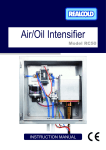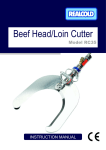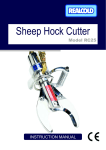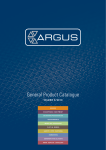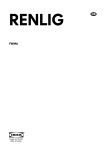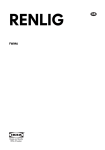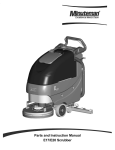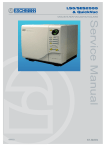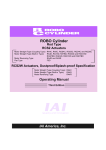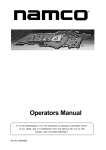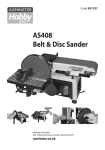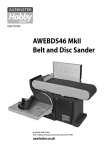Download RC31 Service Manual - argus realcold pty limited
Transcript
Sheep Brisket Shear Model RC31 INSTRUCTION MANUAL Imported by: Licensed distributor Designation: Model No: Specifications: Sheep Brisket Shear RC31 Type: Length: Height: Width: Blade Opening: Blade Reach: Weight: 1105 515mm 620mm 180mm 150mm 335mm 13.75Kg Pneumatic Circuit: 6.5-7.85Bar/90-110Psi Serial No: Manufacture Date: Manufactured By: Argus Realcold Ltd PO Box 12-519 9 Prescott Street, Penrose Auckland, New Zealand Ph ++64 9 526 5757 Fax ++64 9 526 5755 Supplied TABLE OF CONTENTS SAFETY INSTRUCTIONS 1 NOTICE TO OPERATORS 2 INSTRUCTIONS FOR COMMISSIONING 3 SERVICE SECTION 4 Principle of Operation: Cutting Cycle: Opening Cycle: Service Section: Handtool Disassembly: Operating Valve: Frame Assembly: Pneumatic Cylinder: Blades: Reassembly: 4 4 4 5 5 6 7 9 11 13 APPENDIX 1 15 Brisket Shear Parts List Brisket Shear Parts Operating Valve Parts Frame Assembly Parts Pneumatic Cylinder Parts Blades, Matched Pair Parts Order Form 16 17 18 19 20 21 22 APPENDIX 2 23 Maintenance: Check Daily: Check Weekly: Routine Maintenance: 24 24 25 26 APPENDIX 3 27 Blade Sharpening: Fixed Blade: Moveable Blade: 28 29 30 APPENDIX 4 31 Recommended Spare Parts 32 APPENDIX 5 33 Circuit Schematic 34 Argus Realcold Ltd, PO Box 12-519, 9 Prescott Street, Penrose, Auckland, New Zealand Phone +64-9-526 5757, Fax +64-9-526 5755, Email : [email protected] , www.argus.co.nz Issue Date: 21-2-2005 Revision Number: 1.0 Revision Date: 21-2-2005 SAFETY INSTRUCTIONS FOR REALCOLD HAND TOOLS As a designer, manufacturer, and supplier of plant and equipment Argus Realcold Ltd has provided plant, equipment, and all relevant information to ensure the safe use in accordance with the New Zealand Health and Safety in employment Act 1992. The “CE” marked machines provided by Argus Realcold Ltd also meet the EC machinery directive 98/37/EC and any other relevant EC directive. It is the responsibility of the owner to ensure that the machine is used safely in accordance with the instructions and for the purpose that the machine was designed for. The hand tools that we supply, with the exception of the RC33, are designed for two-handed operation and include the following: RC20 Sheep Light Duty Scissor RC21 Sheep Hock Cutter (Various blade options available) RC22 Hydraulic Sheep Hock/Horn/Neck Cutter RC25 Hydraulic Heavy Duty Sheep/Goat/Deer Hock/Horn Cutter RC30 Hydraulic Beef Hock/Horn Cutter, Hog Head Cutter (Various blade options available) RC31 Pneumatic Sheep & Lamb Brisket Opener RC33 Pneumatic Wool Shear RC35 Hydraulic Beef Loin/Head Cutter (Various blade options) RC45 Hydraulic Heavy Duty Beef Horn Cutter RC50 Air/Oil Intensifier Argus Realcold Ltd, PO Box 12-519, 9 Prescott Street, Penrose, Auckland, New Zealand Phone +64-9-526 5757, Fax +64-9-526 5755, Email : [email protected] , www.argus.co.nz 1 NOTICE TO OPERATORS, MAINTENANCE, AND CLEAN-UP PERSONNEL OPERATORS Stop using a defective or malfunctioning tool immediately. Report the problem or defect immediately to your supervisor for removal of tool from service. Do not attempt to make repairs yourself; do not tamper with a defective or malfunctioning tool. Do not attempt to free a jammed or blocked tool yourself. Remove power from the tool when the tool is left unattended or is not in use. Never tie-down, bypass, or alter the triggers or safety switches of the tool. Wear safety glasses when operating this tool. Do not activate switches of the tool unless you intend to operate and use the tool. Do not allow unauthorised individuals to operate the tool. Never place fingers, hands, or other parts of your body in the cutting path of the tool. This tool is capable of causing severe injury or death if misused. CLEAN-UP PERSONNEL Shut off all power and disconnect all hydraulic and air hoses from the tool before performing clean up. Take extreme care near sharp blades. MAINTENANCE PERSONNEL Shut off all power and disconnect all hydraulic and air hoses from the tool before making repairs, performing maintenance, and before replacing or sharpening blades. Do not use substitute parts or use other than genuine Argus Realcold brand parts. Use extreme care when testing or operating the tool. Argus Realcold Ltd, PO Box 12-519, 9 Prescott Street, Penrose, Auckland, New Zealand Phone +64-9-526 5757, Fax +64-9-526 5755, Email : [email protected] , www.argus.co.nz 2 RC31-1105 SHEEP BRISKET SHEAR INSTRUCTIONS FOR COMMISSIONING 1. Mount a suitable spring balancer unit with a weight range from 9Kg to 15Kg near the operating station, in an appropriate position to ensure ease of operation for the suspended tool. 2. Attach a D-shackle to the hanger mount hole at the rear of the flat frame tang. 3. Attach the balancer cable to the D-shackle. 4. Install a ½ inch air line near the tool, with sufficient length to allow full extension of the balancer cable. 5. Arrange the air line so that it follows the balancer cable, and does not interfere with the cables travel. 6. Install the supplied female pneumatic coupler into the ½ inch air line and secure it with the supplied Oetiker clamp. 7. Connect the air line to the male pneumatic coupler and operate the tool a few times. 8. Tie the air line and arrange it so that it is out of the way of the operator. Your RC31 Hand tool is now ready for service. Argus Realcold Ltd, PO Box 12-519, 9 Prescott Street, Penrose, Auckland, New Zealand Phone +64-9-526 5757, Fax +64-9-526 5755, Email : [email protected] , www.argus.co.nz 3 Service Section Before servicing this tool it is important to understand how this tool operates. While being very simple, understanding the principles of operation and their interaction will assist you to maintain the tool to optimum working efficiency. Fault diagnosis and repair will also be greatly simplified. Principle of Operation: Cutting Cycle: Safety handle is twisted and operating lever is depressed actuating the operating valve. • The operating valve supplies air pressure to the rear port of the pneumatic cylinder. • Pressure in the pneumatic cylinder causes the pneumatic piston to move, thus applying pressure to the moveable blade. • The movement of the piston rod assembly is now transmitted to the moveable blade and the blades close. • Pneumatic pressure will build to 6.7 bar/100 PSI as soon as cutting pressure is exerted, causing the blades to cut through the sheep’s brisket. Opening Cycle: • Operating lever is released allowing the operating valve to return to it’s at rest position. The safety handle is released and locks the operating lever into position. • The operating valve supplies air pressure to the front port of the pneumatic cylinder. • Pneumatic pressure is applied to the front of the piston to push the piston rod assembly back in the pneumatic cylinder to the at rest position. • The movement of the piston rod assembly now pulls the moveable blade to the open position. The operating cycle is now complete. 4 Service Section: Before any servicing is attempted on this tool disconnect and unplug from air supply. The air supply hose must be disconnected to render the tool inoperative according to Occupational Safety & Health requirement. Grasp the yoke and pull the piston rod out so that the blades overlap, covering the cutting edges, before removing the tool from the balancer Handtool Disassembly: Before starting please make sure that the tool is clean and that you have a suitable work area available. A container will help prevent small parts from being lost or damaged. 1. Place the tool o n a bench. 2. Grasp the yoke and pull the piston rod out so that the blades overlap, covering the cutting edges. 3. Cut the zip tie securing the two 10mm air hoses together. Disconnect the 10mm air hoses from the swivel elbows on the pneumatic cylinder assembly. 4. Remove one of the circlips securing the yoke pin, and the grub screw securing the trunnion pin, and place into the parts container. Remove the yoke pin taking care that blades do not swing. Remember that they are sharp! 5. Withdraw the trunnion pin and remove the pneumatic cylinder assembly from the tool. Put the cylinder aside on the bench. 6. Loosen the two bolts and nuts securing the blades to the frame and remove . Put them into the parts container. Put the blades aside on the bench. 7. Mount the frame assembly into a vice; use the flat faces of the trunnion pivot mount. Take care to use soft jaws to prevent damaging the mounting faces. Note: Now is a good time to inspect the safety handle and operating lever for correct fit and functioning. 8. Disconnect the two 10mm air hoses from the swivel elbows on the operating valve. 9. Loosen and remove the two cap screws securing the operating valve to the frame. Put the operating valve aside on the bench. Your RC31 hand tool is now disassembled ready for servicing. 5 Operating Valve: 1. Loosen the two cap screws holding the rear cover in place. Make sure to hold the cover firmly in place agains t the tension of the valve spring while loosening the screws. 2. Carefully release the rear cover and put it into the parts container with the valve spring. 3. Depress the valve stem and withdraw the valve spool and stem from the rear of the valve. 4. Remove the O-rings from the spool. 5. Clean all parts thoroughly. 6. Install new O-rings and apply a little air tool oil to the bore of the valve. 7. Install the valve spool and stem into the valve from the rear. Install the valve spring into the centre bore of the valve spool. 8. Locate the free end of the valve spring into the pocket on the inside face of the rear valve cover. Push the cover into place against the pressure of the valve spring. 9. Apply a small amount of blue Loctite 243 to the threads of the cap screws and tighten them into place to secure the cover. 10. Mount the operating valve onto the frame. Use the two cap screws removed during disassembly to secure it into place. Use a small amount of blue Loctite 243 on the threads of the cap screws. Note: Make sure that the valve stem is centred in the frame hole. 6 Frame Assembly: 1. Visually inspect the frame for cracks or other damage. 2. Mount the frame assembly in a vice using the flat sides of the clevis mount boss. Use soft jaws and a rag to prevent damage. 3. Check the fit of the operating lever and safety handle. Pull the operating lever with the safety handle in the locked position. The lever should not be able to significantly move the operating valve stem. There should be minimal lateral play of the operating lever on its pivot. Should the operating lever move the valve stem significantly then the operating lever and safety handle must be replaced. Should there be excessive lateral play then tighten the pivot bolt nuts and recheck. If excessive play is still present then the operating lever must be replaced. 4. Loosen and remove the countersunk screw securing the safety handle cap. Remove the handle cap and put it into the parts container. 5. Use a pair of long nose pliers to grasp the safety handle spring. Carefully remove the spring from its locating hole in the safety handle. Pull the spring from the safety handle taking care not to stretch it and put it into the parts container. 6. Slide the safety handle from the inner shaft and place it on the bench. 7. Use two 14mm spanners to loosen the nyloc nuts from the trigger pivot bolt. It is not necessary for both to be removed. Put them into the parts container. 8. While supporting the operating lever, withdraw the pivot bolt. Withdraw the operating lever from the frame and put it on the bench. 9. Clean all parts thoroughly. 10. To install a new operating lever: 10.1. Carefully grind away the stop pin at the top of the operating lever until it fits into the mounting lugs and the pivot bolt can be inserted. There should be about 1mm between the lever and the valve stem when the stop pin is against the frame. 10.2. Install a new pivot bolt and lock nuts. 10.3. Use two 14mm ring spanners to tighten the pivot bolt nuts. Tighten them until there is a minimum of lateral play without any binding of the lever when it is operated. It should be able to fall away from the valve stem under its own weight. 7 11. To install a new safety handle: 11.1. Slide the new safety handle onto the safety handle inner shaft. Line up the bottom flat face of the safety latch with the top edge of the operating lever. Use a scriber to mark the interlocking edge profile onto the end face of the safety latch. 11.2. Mount the safety handle in a vice using the two end faces. Make sure that the safety latch is closest to you and exposed. 11.3. Use a hack saw to cut a triangular wedge from the inside of the safety latch using the scribed mark as a guide. 11.4. Use a half round file to shape the latch face so that the safety latch engages over the operating lever. The handle must be able to rotate freely upward to disengage the safety latch a nd have minimal play when engaged to prevent the operating lever from moving. 12. Insert the safety handle spring into the locating hole on the end face of the safety handle inner shaft. Push it in as far as it will go. 13. Using a pair of long nose pliers grasp the free end of the safety handles spring and guide it into the locating hole at the end of the safety handle. Note: When installing a new spring the free end will require shortening to prevent it from protruding above the surface of the safety handle. 14. Apply a small amount of blue Loctite 243 to the thread of the counter sunk screw and install it through the safety handle cap into the end of the safety handle inner shaft and tighten. The handle frame assembly is now ready to be returned to service. 8 Pneumatic Cylinder: 1. Mount the cylinder in the vice using the flat faces of the cylinder body. Use soft jaws to prevent damage to the cylinder. 2. Loosen and remove the 6mm grubscrew from the yoke. Put it into the parts container. 3. Gripping the flat faces of the piston rod with a spanner, loosen and remove the yoke. Put it into the parts container. 4. Loosen and remove the four button screws holding the guard plate to the cylinder head. Remove the guard plate and put it into the parts container along with the button screws. 5. Grip the cylinder head using a spanner across the flat faces. Loosen by turning anti-clockwise and remove the cylinder head. Put it on the bench. 6. Grasp the piston rod and withdraw it from the cylinder body. Put it on the bench. 7. Seals may be easily removed by hooking them from their locating grooves. Take care not to damage the piston or cylinder head. The seals should be replaced each time the tool is serviced. Use only genuine Argus Realcold seals for replacement. 8. Clean all parts thoroughly. 9. Check the cylinder body for damage. External damage may be far from cosmetic. It can cause distortion of the cylinder bore, which will damage seals and/or cause them to leak. It may also damage the piston. Look particularly for localised shiny areas inside the bore. If the cylinder body is damaged then replace it. 10. Check the piston and rod for damage. Be aware that even insignificant appearing damage will cut and damage the cylinder head seals, causing them to leak. The cylinder head bearing may also be damaged reducing its ability to hold the piston and rod straight, causing seal leakage. If the piston or rod is damaged then replace the piston and rod assembly. 11. Check the cylinder head bearing for wear or damage. The bearing has a thin bronze coating on the inside surface. If this is worn through or damaged then replace it. 11.1. To replace the cylinder head bearing: Mount the cylinder head in a vice. Use soft jaws and rags to prevent damage. 11.2. Carefully drive the bearing out using a pin punch. Take care not to damage the cylinder head. 11.3. Take the new bearing and use a press to install it until the end face is flush with the face of the cylinder head. If you do not have a press available you can use the vice to push the bearing into place. Do not install the bearing with hammer and punch. 9 12. Install the new seal into the front of the cylinder head. Make sure that the protruding lip is facing towards the front. Install the new O-ring over the threaded portion of the cylinder head. Make sure that the buffer is firmly in place on the rear face of the cylinder head. Apply a coating of general purpose grease to the seal, bearing, and threads of the cylinder head. 13. Install the new piston seal into the middle groove of the piston, and the plastic bearing strip into the rearmost piston groove. Make sure that the buffer is firmly in place on the rear face of the piston. Apply a coating of general purpose grease to the piston, seal, and bearing. Carefully install the piston and rod assembly into the cylinder and push it all the way in until it stops. 14. Mount the cylinder in the vice using the flat faces of the cylinder body. Use soft jaws to prevent damage to the cylinder. 15. Install the cylinder head over the piston rod and screw it into the cylinder body. 16. Tighten until the flat faces of the cylinder head are aligned with the flat faces at the rear of the cylinder body. Clean off any excess grease. 17. Apply a small amount of blue Loctite 243 to the male thread of the piston rod. Screw the yoke onto the piston rod and tighten. Tighten the grubscrew to lock the yoke into place. 18. Place the guard plate onto the front of the cylinder head, over the piston rod. Make sure that the fold is placed opposite to the cylinder head port. Secure into place using the four M10 button head screws removed earlier. The pneumatic cylinder is now ready to be returned to service. 10 Blades: 1. Mount the blade assembly into the vice; use the mounting face and soft jaws to prevent damage. 2. Loosen and remove the nyloc nut from the pivot bolt. Put it into the parts container. 3. Grasp the moveable blade and loosen the pivot bolt. Remove it and put it into the parts container. Place the blades on the bench. 4. Inspect the blades for nicks or cracks along the cutting edge. These will quickly develop into cracks if left unattended, leading to dangerous failure of the blade. The blades may be touched up according to the mainte nance instructions in appendix 2. Do not attempt to sharpen your blades until you have familiarised yourself with the content of this appendix. If regrinding it is critical that the blade angles are maintained. This will ensure that your blades maintain peak cutting efficiency. Argus Realcold offers a blade sharpening service. You will find this service to be very cost effective in maintaining your hand tool at peak cutting efficiency. 5. Inspect the pivot bolt bush and yoke pin bush for wear and for roundness. The blade bushes need only be removed should they require replacement. Bushes and pivot bolt should be replaced together; do not install a new pivot bolt into old bushes, or an old pivot bolt into new bushes. 5.1. Using a suitable sized punch, drive the blade bushings from their holes. 5.2. Use a press to push the new bushes into place. If you do not have a press available you can use the vice to push the bearing into place. Do not install the bushes with hammer and punch. 6. Mount the fixed blade into the vice. 7. Coat one face of the pivot bolt washer with food grade grease and install it over the shank of the pivot bolt with the greased face away from the head. Coat the shank of the pivot bolt with food grade grease as well. 8. Coat the pivot area of the moving blade with food grade grease. Place the moveable blade against the fixed blade, lining up the pivot hole with the threaded hole of the fixed blade. 9. Take the pivot bolt with it’s washer in place and insert it through the moveable blade pivot hole into the threaded hole of the fixed blade. Screw it in until the pivot bolt washer is against the face of the moveable blade. 11 10. Take the Nylok nut and screw it onto the exposed threads of the pivot bolt. The Nylok blade pivot nut should not be reused more than once. The nylon locking insert deforms and loses its ability to hold the nut securely with repeated reuse. 11. Fit the open end of a 1inch spanner over the pivot bolt and tighten fully to expel excess grease. Loosen the pivot bolt until the moveable blade slides easily against the fixed blade. Continuing to hold the pivot bolt with the spanner, use a 3/4 inch spanner to tighten the pivot nut. 12. Check that the moveable blade still slides freely. If it does not then loosen the lock nut. Loosen the pivot bolt a little at a time, retightening the pivot nut and checking blade movement until a satisfactory tension is attained. The shear blades are now ready to be returned to service. 12 Reassembly: Before starting, make sure that all parts are clean and free of oil and grease. All replacement parts and/or serviced parts should be procured/completed and ready to hand. 1. Take the handle frame assembly and insert the two blade mounting bolts through the mounting holes at the top of the frame. Make sure that the bolt heads are on the same side as the safety handle so that the operator cannot harm himself by contact with the bolt ends. 2. Place the blade assembly onto the frame over the two blade mounting bolts. The blade has three mounting holes; use the hole at the end of the mounting face and the hole nearest to the blade cutting edge. Should the hole near the back of the blade be used the pneumatic cylinder will stroke past the fixed blade causing damage. 3. Take the remaining two Nylok nuts, screw them onto the blade mounting bolts and tighten. The Nylok nuts should not be reused more than once. The nylon locking insert deforms and loses its ability to hold the nut securely with repeated reuse. 4. Check that the blade is secured flat against the handle frame. If it is contacting the weld at the blade mount base or the weld at the trigger mount the mark the contact area. Remove the blades and use a linisher to relieve the blade edge at the point of contact until clearance is achieved. Refit the blades and recheck that the blade is flat against the frame. Important: if the blade does not mount flat against the frame the pneumatic cylinder will not line up correctly. The blades may become overstressed by this misalignment and break. 5. Take the pneumatic cylinder and slide the rear clevis mount into position over the clevis mount boss of the handle frame. Make sure that the rear pneumatic elbow is pointing downwards towards the bottom of the tool. Insert the trunnion pin through the clevis mount and through the handle frame until the ends are flush with the clevis mount bushes. Tighten the grub screw in the bottom of the handle frame to secure. 6. Grasp the pneumatic cylinder yoke and pull the piston rod to full extension. 7. Pivot the pneumatic cylinder and slide the yoke into position over the moveable blade. Align the yoke holes with the moveable blade bush and insert the yoke pin through the yoke and the blade bush. Secure with circlips. Make sure that they are seated firmly in their grooves. 13 8. Check the air lines. It is recommended that these airlines be polyurethane, which is a soft and flexible material. Use of nylon hose is to be avoided as it is easily kinked. To replace the hoses: 8.1. Pull the old hoses out of the frame. 8.2. Push a length of new hose into the hole at the bottom of the frame on the right hand side. Continue pushing it through the handle frame until the end is visible through the hole at the top of the frame on the right hand side. 8.3. Grasp the end of the hose with a pair of long nose pliers and pull it through the hole. Push the end of the hose into the fitting on the side of the operating valve. Pull the other end of the hose until the top end is following a gentle curve with no kinks to the operating valve elbow. 8.4. Take the free end and curve it towards the front of the pneumatic cylinder. Lay the hose against the side of the front pneumatic cylinder elbow and cut it to a suitable length. Make sure that there is enough hose to be able to secure it to the other hose at the rear and to fle x freely without kinking or stretching as the tool is operated. Insert the end into the front pneumatic cylinder elbow. 8.5. Push a length of new hose into the hole at the bottom of the frame at the left hand side. Continue pushing it through the handle frame until the end is visible through the hole at the top of the frame on the right hand side. 8.6. Grasp the end of the hose with a pair of long nose pliers and pull it through the hole. Push the end of the hose into the fitting on the side of the operating valve. Pull the other end of the hose until the top end is following a gentle curve with no kinks to the operating valve elbow. 8.7. Take the free end and curve it towards the rear of the pneumatic cylinder. Lay the hose against the side of the rear pneumatic cylinder elbow and cut it to a suitable length. Make sure that there is enough hose to be able to secure it to the other hose at the rear and to flex freely without kinking or stretching as the tool is operated. Insert the end into the rear pneumatic cylinder elbow. 8.8. Use a cable tie to secure the two hoses together near the rear pneumatic cylinder elbow. 9. Connect the air lines to the pneumatic cylinder and to the operating valve. Check the parts container and bench for any missing parts now. Your RC31 hand tool is now ready to be returned to service. Reinstall as per installation instructions at front of the manual and test for correct operation. 14 Appendix 1 Appendix 1 Parts Diagram and Ordering Form Argus Realcold Ltd, PO Box 12-519, 9 Prescott Street, Penrose, Auckland, New Zealand Phone +64-9-526 5757, Fax +64-9-526 5755, Email : [email protected] , www.argus.co.nz 15 RC31-1105 STANDARD DUTY SHEEP BRISKET SHEAR ITEM NO. QTY. PART NO. 1 1 110-312101-A 2 1 130-314101-A 3 1 130-314102-A 4 1 130-314105-A 5 1 140-315107-A 6 1 170-318102-A 7 1 170-318103-A 2 180-DU16x18x15 8 2 180-101471028 9 2 180-101471038 10 1 180-154202828 11 2 180-24A000028 12 1 180-910102 13 1 180-KK13P-02M 14 1 180-KK13S-13B 15 1 180-OT-1720 16 1 190-319508-A 17 1 190-319510-A 18 1 200-316607-A 19 4 800-BHM1020-304 20 4 800-CSM1035-304 21 2 800-CSM616-304 22 2 800-FWM12-304 23 2 800-FWM6-304 24 2 800-GSM66-304 25 2 800-HBUNC3-8x175-304 26 2 800-NLC3-8UNC-304 28 1 800-TU1065-BU 29 2 800-ZCME11 DESCRIPTION. PNEUMATIC CYLINDER COMPLETE YOKE YOKE PIN TRUNNION PIN SHEAR BLADE MATCHED PAIR PROTECTIVE PLATE CLEVIS MOUNT DU BUSH 10mm 1-4 ELBOW 10mm 3-8 ELBOW 1-4 BSP NIPPLE 1-4 BANJO BOLT 1-4 BSP ELBOW FEMALE 1-4 COUPLER MALE 1-2BARB COUPLER FEMALE OETIKER CLAMP OPERATING VALVE EXHAUST MANIFOLD BRISKET SHEAR FRAME ASSY M10x20 BUTTON HEAD SCREW CAP SCREW M10x35 CAP SCREW M6x16 M12 FLAT WASHER M6 FLAT WASHER M6x6 GRUB SCREW 3-8x1.75" UNC HEX BOLT 3-8 UNC NYLOC NUT 10mm POLYURETHANE TUBE CIRCLIP RC31-1105 STANDARD DUTY SHEEP BRISKET SHEAR 11 22 17 16 10 8 15 18 14 23 13 21 26 12 28 24 20 5 7 4 25 7 9 9 1 19 29 6 2 3 24 ITEM NO. QTY. 1 1 2 1 3 1 4 1 5 1 6 1 7 1 8 2 9 4 9 7 PART NO. 190-312105-A 190-319600-A 190-319601-A 190-319603-A 190-319605-A 190-319606-A 190-319607-A 190-319608-A 800-CSM612-304 4 1 DESCRIPTION SEAL KIT VALVE BODY VALVE SPOOL VALVE SPRING VALVE STEM COVER PLATE, FRONT COVER PLATE, REAR PORT PLUG CAP SCREW M6x12 3 5 8 2 6 RC31 OPERATING VALVE 190-319508-A 8 9 7 3 4 ITEM NO. QTY. PART NO. 1 1 150-316606-A 2 1 150-316607-A 1 150-316607-2-A 1 800-DP312 1 800-CSKM820-304 3 1 150-316608-A 4 1 150-316609-A 5 1 150-316610-A 6 1 160-317109-A 7 1 800-CSKUNC3-8X1-304 8 2 800-NLC3-8UNC-304 1 2 8 DESCRIPTION. SAFETY HANDLE HANDLE FRAME SAFETY HANDLE INNER M3x12 DOWEL PIN M8x20 COUNTER SUNK SCREW SAFETY HANDLE CAP SAFETY HANDLE SPRING OPERATING LEVER TRIGGER PIVOT BOLT 3-8x1"UNC COUNTER SUNK SCREW 3-8 UNC NYLOC NUT 6 5 2 2 8 2 RC31 BRISKET SHEAR FRAME ASSY 200-316607-A PART NO. 110-312102-A 110-312103-A 110-312104-A 110-312105-A 110-312107-A 4 2 4 5 4 3 DESCRIPTION PNEUMATIC CYLINDER BODY PNEUMATIC CYLINDER HEAD PNEUMATIC CYLINDER PISTON & ROD ASSY PNEUMATIC CYLINDER SEAL KIT PNEUMATIC CYLINDER BEARING RC31 PNEUMATIC CYLINDER COMPLETE 110-312101-A ITEM NO. QTY. 1 1 2 1 3 1 4 1 5 1 4 4 4 1 ITEM NO. QTY. 1 1 2 1 3 1 4 1 5 1 6 1 7 1 PART NO. 140-315108-A 140-315109-A 160-317101-A 160-317106-A 160-317107-A 160-317108-A 800-NLC1-2UNC-304 1 DESCRIPTION SHEAR BLADE FIXED SHEAR BLADE MOVEABLE PIVOT BOLT PIVOT BOLT WASHER PIVOT BOLT BUSH YOKE PIN BUSH 1-2 UNC NYLOC NUT 7 6 2 RC31 SHEAR BLADE MATCHED PAIR 140-315107-A 5 4 3 ? 9 Prescott Street PO Box 12-519 Penrose, Auckland New Zealand Ph 09 526 5757 Fax 09 526 5755 [email protected] Order Number Date Tool Serial Number Customer Order Form Name Address Phone Contact Person Qty Part Number Description Shipping Instructions: Ship to Address Attention Level of Urgency Normal Urgent 22 Appendix 2 Appendix 2 Maintenance Argus Realcold Ltd, PO Box 12-519, 9 Prescott Street, Penrose, Auckland, New Zealand Phone +64-9-526 5757, Fax +64-9-526 5755, Email : [email protected] , www.argus.co.nz 23 Maintenance: Please read this section thoroughly and make sure that these maintenance checks are carried out routinely as specified. Adherence to this maintenance schedule will ensure that you enjoy long and trouble free service from your hand tool. Before any servicing is attempted on this tool, disconnect and unplug from air supply. All hydraulic hoses and air supply hoses must be disconnected to render the tool inoperative according to Occupational Safety & Health requirement. Check Daily: 1. Clean the hand tool thoroughly before inspecting. 2. Visually inspect the hand tool for any obvious damage to components, and for loose components. Anything that you find at this stage must be remedied immediately. The hand tool may need to be removed from service to affect remedy. 3. Check the operation of the safety handle and operating lever. Pay particular attention to the way the safety handle engages with the lug on the safety handle. Often adjustment of the trigger pivot bolt to take up excess play is all that is required to ensure the effectiveness of the safety mechanism. 4. Check the condition of the hoses and pneumatic elbows. If they are damaged then replace them. 5. Listen for air leaking past the front of the cylinder head seal. If there is air leaking then the cylinder head seal is bypassing and must be replaced. 6. Check pivot bolt tension as per the blades subsection in the service section of this manual. The yoke pin will need to be removed to facilitate this. Once the pivot bolt has been properly adjusted, apply grease to the moveable blade around the yoke end and to the shank of the yoke pin before reinstalling. 7. Wipe off excess grease before returning the hand tool to service. 8. Check for water in the air line water trap and also the condition of the air filter (where applicable). 9. Reconnect the hand tool and check that all couplers and fittings are tight. 10. Reconnect the air supply and test for correct operation. These checks are to be performed on a daily basis, or prior to the start of each shift where more than one shift operates each day. 24 Check Weekly: This maintenance is best performed in the workshop. 1. Remove the blades from the hand tool as per the instructions for disassembly. 2. Thoroughly clean the frame, cylinder, yoke, and blades. The grease used for lubrication becomes dry and hard, building up a layer of dried grease after repeated exposure to heat from the sterilising process. 3. Visually inspect the hand tool for any obvious damage to components, and for loose components. Check all fasteners for tightness. Anything that you find at this stage must be remedied immediately. 4. Check the yoke pin, yoke, pivot bolt, and blade bushes for wear as per the instructions for servicing. If they are loose or obviously worn then replace them now. 5. Check the blades for sharpness or edge damage. Should they be dull or damaged then sharpen them as per the sharpening instructions in appendix 3. Sharpen both blades evenly. 6. Apply grease to the pivot faces of the blades. Reassemble them to the tool as per the instructions for reassembly. Make sure to tension the pivot bolt correctly. 7. Wipe off excess grease before returning the hand tool to service. 8. Reconnect the hand tool and check that all couplers and fittings are tight. 9. Reconnect the air supply and test for correct operation. These checks are to be performed on a weekly basis, or approximately every 40 hours of service where more than one shift operates each day. 25 Routine Maintenance: Except where daily or weekly checks require replacement of wear items, the hand tool should be fully stripped and serviced once every six months. Wear items that should be replaced at this six month service are: • • • • • • • • 110-312105-A 130-314102-A 160-317101-A 160-317106-A 160-317107-A 160-317108-A 800-NLC1-2UNC-304 800-ZCME11 Seal kit Yoke pin Pivot bolt Pivot bolt washer Pivot bolt bush Yoke pin bush 1/2UNC Nyloc nut Circlip All other components should be assessed for serviceability at this time and replaced as necessary, as per the servicing instructions in the service section of this manual. Other factors which may necessitate a full service prior to this six month interval include but are not limited to: • • • Large volumes of water present in the air supply Blades damaged Other damage caused by dropping or striking of the tool Following the discovery of any of these occurrences the hand tool must be removed from service, stripped, and thoroughly assessed for damage. 26 Appendix 3 Appendix 3 Blade Sharpening Argus Realcold Ltd, PO Box 12-519, 9 Prescott Street, Penrose, Auckland, New Zealand Phone +64-9-526 5757, Fax +64-9-526 5755, Email : [email protected] , www.argus.co.nz 27 Blade Sharpening: Use a linisher with a belt of about 240grit. Linish gently along the full length of the cutting edge primary angle. Take care to maintain the angle of the edge (30°), and also the profile. See next page for individual blade sharpening considerations. Use only light pressure as heat may rapidly build up and affect the hardness of the blade. Use a stone to apply a witness to the cutting edge and remove the burr created by linishing. If a linisher is not available then a sanding drum attached to a die-grinder may be used. Under no circumstance should an angle grinder or disc sander be used. Failure to follow these sharpening instructions will void the manufacturer’s warranty. Argus Realcold Ltd offer a blade reconditioning service that will restore your blades to the original condition, which you will find to be very cost effective in maintaining your blades at peak efficiency. Argus Realcold Ltd, PO Box 12-519, 9 Prescott Street, Penrose, Auckland, New Zealand Phone +64-9-526 5757, Fax +64-9-526 5755, Email : [email protected] , www.argus.co.nz 28 Fixed Blade: A C B Blade chordal width at point “A” should not be reduced to less than 55mm. As the chordal width reduces the blade may become more susceptible to failure. The cutting edge should not be extended up into the root radius beyond “A.” Material removal should be even along the full length of the cutting edge, regardless of whether a section of the edge requires to be sharpened more than another section. It is common for the sections near the root of the edge and the tip to be sharpened further than the mid section at “B.” This affects the edge geometry and results in the edge at “B” being contacted first by the moveable blade rather than the edge engaging progressively from the root. When this occurs it becomes possible for the blades to cross at “B” and this invariably leads to breakage of the blade. Pay particular attention to this area when reassembling the blades to be sure that the blade geometry has been maintained. A template may be easily made to use as a geometry guide when sharpening. Always linish along the length of the cutting edge so as not to score the blade across the chord and introduce stress focal points. Pay attention to maintain the cutting edge angle at 30°. Never use an angle grinder to sharpen your blades. These are too aggressive and build up heat rapidly at the point of contact. This alters the hardness of the blade in small localised areas making the blades prone to fracture. Be aware that a surface colour change does not need to occur for heat damage to have taken place. Deep scores are always left across the chord, further weakening the blade. This damage can never be repaired by linishing. Make sure that edge “C” is radiused to clear the weld on the frame at the mounting face. This must be performed to suit each tool due to production variances between individual frames at manufacture. 29 Moveable Blade: B A Blade chordal width at point “A” should not be reduced to less than 45mm. As the chordal width reduces the blade may become more susceptible to failure. The cutting edge should not be extended up into the root radius beyond “B.” Material removal should be even along the full length of the cutting edge, regardless of whether a section of the edge requires to be sharpened more than another section. It is common for the mid section of the edge to be sharpened further than the root and the tip sections. When this occurs it becomes possible for the blades to cross at the tip and this invariably leads to breakage of the blade. Pay particular attention to this area when reassembling the blades to be sure that the blade geometry has been maintained. A template may be easily made to use as a geometry guide when sharpening. Always linish along the length of the cutting edge so as not to score the blade across the chord and introduce stress focal points. Pay attention to maintain the cutting edge angle at 30°. Never use an angle grinder to sharpen your blades. These are too aggressive and build up heat rapidly at the point of contact. This alters the hardness of the blade in small localised areas making the blades prone to fracture. Be aware that a surface colour change does not need to occur for heat damage to have taken place. Deep scores are always left across the chord, further weakening the blade. This damage can never be repaired by linishing. 30 Appendix 4 Appendix 4 Recommended Spare Parts Argus Realcold Ltd, PO Box 12-519, 9 Prescott Street, Penrose, Auckland, New Zealand Phone +64-9-526 5757, Fax +64-9-526 5755, Email : [email protected] , www.argus.co.nz 31 Recommended Spare Parts The following is a list of spare parts that we recommend your engineering department to keep in stock at all times. Having these parts on hand will assist you to maintain your tool in good working order, and ensure that you avoid down time while waiting for parts delivery should your hand tool require repair. This list is a minimum recommendation for parts to support one unit in the field. Where more than one tool is in service, quantities held in stock should be adjusted accordingly. Qty Part Number Description 2 110-312105-A PNEUMATIC CYLINDER SEAL KIT 2 130-314101-A YOKE 4 130-314102-A YOKE PIN 1 140-315107-A SHEAR BLADE MATCHED PAIR 2 150-316609-A SAFETY HANDLE SPRING 2 160-317101-A PIVOT BOLT 4 160-317106-A PIVOT BOLT WASHER 2 160-317107-A PIVOT BOLT BUSH 2 160-317108-A YOKE PIN BUSH 1 170-318102-A PROTECTIVE PLATE 2 180-101471028 10mm 1/4 ELBOW 4 180-101471038 10mm 3/8 ELBOW 2 190-312105-A OPERATING VALVE SEAL KIT 8 800-NLC3-8UNC-304 3/8UNC NYLOC NUT 4 800-NLC1-2UNC-304 1/2UNC NYLOC NUT 5m 800-TU1065-BU HOSE 10 800-ZCME11 CIRCLIP Argus Realcold Ltd, PO Box 12-519, 9 Prescott Street, Penrose, Auckland, New Zealand Phone +64-9-526 5757, Fax +64-9-526 5755, Email : [email protected] , www.argus.co.nz 32 Appendix 5 Appendix 5 Circuit Diagram Argus Realcold Ltd, PO Box 12-519, 9 Prescott Street, Penrose, Auckland, New Zealand Phone +64-9-526 5757, Fax +64-9-526 5755, Email : [email protected] , www.argus.co.nz 33 ITEM 1 2 3 10mm DESCRIPTION OPERATING VALVE 5/2 SPRING RETURN HAND TOOL CYLINDER D/A PNEUMATIC AIRLINE COUPLING QUICK RELEASE PNEUMATIC SUPPLY 6.7Bar/100Psi 3 EX2 IN EX1 1 CYL1 COPYRIGHT: THIS DOCUMENT IS THE PROPERTY OF ARGUS REALCOLD LTD IT MUST NOT BE COPIED OR THE CONTENTS PASSED ON TO ANY THIRD PARTY WITHOUT THE WRITTEN CONSENT OF THE COMPANY CYL1 CYL2 Q.A MFG APPV'D CHK'D DRAWN B EAST M ROBINS NAME UNLESS OTHERWISE SPECIFIED: DIMENSIONS ARE IN MILLIMETERS SURFACE FINISH: TOLERANCES: LINEAR: ANGULAR: SIGNATURE FINISH: CYL2 DATE MATERIAL: 21-2-2005 21-2-2005 PART NO OLD DEBUR AND BREAK SHARP EDGES 2 SCALE:1:1 PART NO. TITLE: REVISION A SHEET 1 OF 1 RC31-CIRC CIRCUIT DIAGRAM RC31 DO NOT SCALE DRAWING A3








































